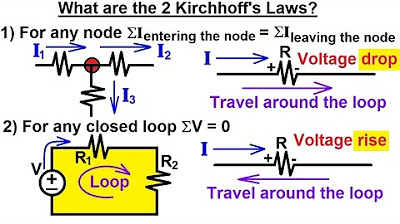Electrical Engineering: Ch 10 Alternating Voltages & Phasors (1 of 82) Alternating Voltages
Summary
TLDRThis lecture introduces the concepts of sinusoidal voltages, alternating currents, and phasors in electrical circuits. It explains how alternating voltages change direction over time, and how currents alternate between clockwise and counterclockwise directions. The equation for sinusoidal voltage is discussed, including the roles of maximum voltage (Vmax), angular frequency (ω), and phase angles. The differences between sine and cosine functions in voltage equations are covered, emphasizing their identical behavior but different starting points. Finally, the period of oscillation and its significance are explained, setting the stage for future discussions on phasors.
Takeaways
- 🔄 Sinusoidal voltages alternate over time, switching between positive and negative directions.
- ⚡ The equation for voltage is expressed as V_max * sin(Ωt + φ), where V_max is the maximum voltage and φ is the phase angle.
- 🔂 The voltage alternates in cycles, going from positive to zero, to negative, and back to zero.
- 📏 The peak-to-peak voltage is twice the maximum voltage, from the highest to the lowest point.
- 🔄 Omega (Ω) represents the angular frequency and is related to the frequency (f) by Ω = 2πf.
- ⏳ Frequency is measured in Hertz (Hz) and represents the number of cycles per second.
- ↔️ A phase angle causes a shift in the waveform, moving it left or right on the graph depending on the sign of the phase angle.
- 📊 The period is the time it takes for one complete cycle of the waveform to occur.
- 🎚️ Sinusoidal voltage can be represented using either a sine or cosine function, depending on the starting point of the cycle.
- 🔄 In an alternating voltage source, the current and voltage will alternate directions within each cycle.
Q & A
What is a sinusoidal voltage?
-A sinusoidal voltage is an alternating voltage that alternates over time, changing from positive in one direction to positive in the opposite direction, following a sinusoidal pattern.
How does a sinusoidal voltage behave in a circuit with a single voltage source and resistance?
-In such a circuit, the voltage alternates, meaning that for half of the time, the voltage will be positive in one direction, and for the other half, it will be positive in the opposite direction. This causes the current to alternate, moving back and forth through the circuit.
What is the equation for sinusoidal voltage?
-The equation for sinusoidal voltage is expressed as the maximum voltage (V_max) times either the sine or cosine of (Ωt + phase angle), where Ω represents the angular frequency.
What is V_max in the context of sinusoidal voltage?
-V_max is the maximum amplitude of the voltage as it alternates between a positive and negative direction, ranging from a maximum positive value to zero to a maximum negative value.
What is the angular frequency (Ω), and how is it related to frequency (f)?
-The angular frequency (Ω) is the frequency of the alternating voltage in radians per second. It is related to the frequency (f) by the formula Ω = 2πf.
What does a phase angle represent in a sinusoidal voltage equation?
-A phase angle indicates a horizontal shift in the sinusoidal waveform. A positive phase angle shifts the graph to the left, meaning the voltage reaches its maximum value sooner, while a negative phase angle shifts the graph to the right.
What is the period of oscillation in a sinusoidal voltage?
-The period of oscillation is the time taken for one complete cycle of the sinusoidal wave, measured from one peak to the next. It is the inverse of the frequency.
How are sine and cosine functions used in representing sinusoidal voltage?
-Both sine and cosine functions can represent sinusoidal voltage. The choice between them depends on the starting point at time t=0. They have the same amplitude and period but start at different points in the cycle.
What happens to the current in a circuit with an alternating voltage source?
-The current in the circuit will alternate direction, moving clockwise and counterclockwise, as the voltage alternates between positive and negative values.
What is the significance of marking the voltage source with positive and negative ends in an alternating voltage circuit?
-Marking the voltage source with positive and negative ends indicates the direction of the voltage at a given moment. Despite this marking, in an alternating voltage circuit, the actual voltage and current will change direction periodically.
Outlines

This section is available to paid users only. Please upgrade to access this part.
Upgrade NowMindmap

This section is available to paid users only. Please upgrade to access this part.
Upgrade NowKeywords

This section is available to paid users only. Please upgrade to access this part.
Upgrade NowHighlights

This section is available to paid users only. Please upgrade to access this part.
Upgrade NowTranscripts

This section is available to paid users only. Please upgrade to access this part.
Upgrade NowBrowse More Related Video

Rangkaian Listrik - Analisis Mesh (Genap 2019/2020)

8.1. Gelombang Alternating Current (AC) - Rangkaian Listrik

Phasors

AC CIRCUIT| BEE |Lecture 01|INTRODUCTION|First Year Engineering

Electrical Engineering: Basic Laws (8 of 31) What Are Kirchhoff's Laws?

Nodal Analysis EP.16 (Tagalog/English Electronics)
5.0 / 5 (0 votes)